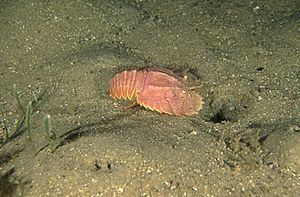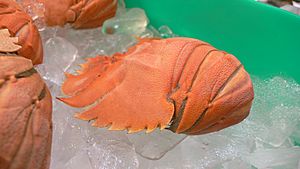Balmain bug facts for kids
Quick facts for kids Ibacus peronii |
|
|---|---|
 |
|
| Conservation status | |
| Scientific classification | |
| Kingdom: | |
| Phylum: | |
| Subphylum: | |
| Class: | |
| Order: | |
| Family: |
Scyllaridae
|
| Genus: |
Ibacus
|
| Species: |
I. peronii
|
| Binomial name | |
| Ibacus peronii Leach, 1815
|
|
The Balmain bug (Ibacus peronii) is a type of slipper lobster. It is also known as the butterfly fan lobster. This interesting creature lives in the shallow waters around Australia. People catch them for food in a small fishing industry. Balmain bugs are flat and reddish-brown. They can grow up to 23 cm (9 in) long and 14 cm (6 in) wide. They have flat antennae and do not have large claws.
Contents
What Does It Look Like?
Like other slipper lobsters, the Balmain bug has a wide, flat body. It has a large, hard shell called a carapace. This shell is reddish-brown. The shell itself can be 2–10 centimetres (0.8–3.9 in) long. The whole animal can reach a length of 23 cm (9 in) and a width of 10–14 cm (3.9–5.5 in).
Its antennae are also long and wide. The flat shape of the Balmain bug helps it bury itself partly in soft sand or mud. They have eight pairs of legs, but no huge claws. Most caught Balmain bugs weigh about 120 grams (4.2 oz). However, they can weigh anywhere from 80 to 200 g (2.8 to 7.1 oz).
People sometimes confuse the Balmain bug with the Moreton Bay bug (Thenus orientalis). But you can tell them apart by looking at their eyes. The Balmain bug's eyes are near its legs. The Moreton Bay bug's eyes are at the very edge of its body.
Where Do They Live and What Do They Do?
Balmain bugs live in waters from 20–450 metres (66–1,476 ft) deep. You can find them off the coast of Australia. Their range stretches from Southport in Queensland to Geraldton in Western Australia. Another group lives in Western Australia, from Port Hedland to Broome. One Balmain bug was even found in Port Phillip Bay in July 2016.
Ibacus peronii are active at night. They eat algae (like seaweed) and small crustaceans. During the daytime, they often hide by burying themselves in sand or mud.
Fishing for Balmain Bugs
The Balmain bug is the most important species in the Ibacus family for fishing. People only catch them from the wild. There is some research happening to try and farm them (called aquaculture). Most Balmain bugs are caught around New South Wales. Fishermen usually catch them by accident while trawling for fish and prawns.
More Balmain bugs are available in January and February. The price is highest where they are caught. This is because people in those areas know and like them more. You can almost always find Balmain bugs at fish markets in Sydney.
Some people say the meat of the Balmain bug tastes a bit like garlic. This makes it less popular for cooking than the Moreton Bay bug. Only the tail of the Balmain bug has meat you can eat. Small bugs give about 30% meat. Larger bugs have smaller tails compared to their body size, so they give less meat.
How It Got Its Name
The species Ibacus peronii was first described by William Elford Leach in 1815. He used samples collected by François Péron. Péron had called the animal Scyllarus incisus before. He had also called it Scyllarus kingiensis.
The place where the first sample was found was simply called "New Holland" (which is now Australia). But old records show it was caught off King Island. This island is in the Bass Strait, between Tasmania and the Australian mainland.
Many common names are used for Ibacus peronii in Australia. These include Balmain bug, Eastern Balmain bug, butterfly lobster, flapjack, Péron's Ibacus crab, sand crayfish, sand lobster, and southern shovel-nosed lobster. Some older names like prawn killer and squagga are not used much anymore. The Food and Agriculture Organization prefers the name butterfly fan lobster. Even though it's best known as the "Balmain bug," three other species of Ibacus also share that name.




